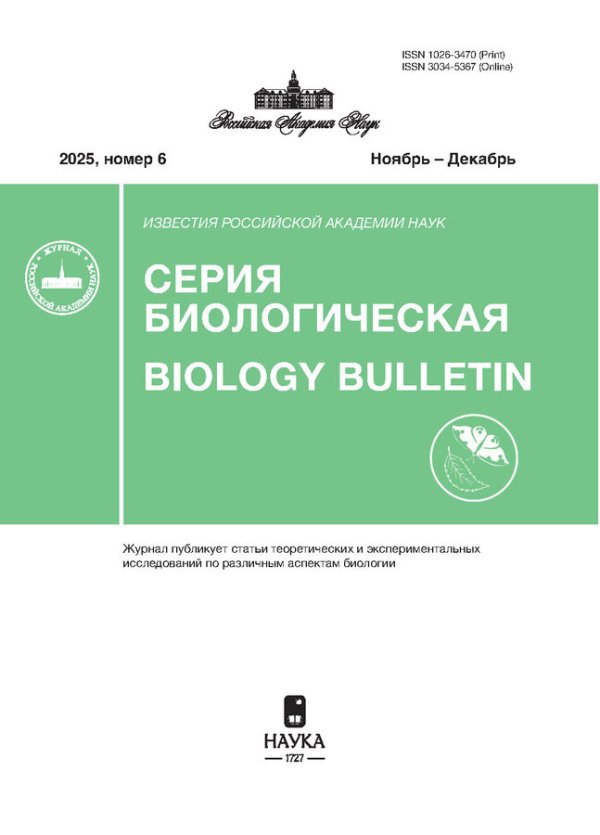Genetic and Morphological Variability of the Small Wood Muse (Apodemus (Sylvaemus) uralensis, Rodentia) in the North Caucasus
- Authors: Tembotova F.A.1, Puzachenko A.Y.1,2, Amshokova A.K.1, Kononenko E.P.1, Emkuzheva M.M.1
-
Affiliations:
- Tembotov Institute of Ecology of Mountain Territories Russian Academy of Science
- Institute of Geography Russian Academy of Science
- Issue: No 8 (2023)
- Pages: 84-102
- Section: КОМПОНЕНТЫ БИОРАЗНООБРАЗИЯ
- URL: https://journals.rcsi.science/1026-3470/article/view/231759
- DOI: https://doi.org/10.31857/S1026347023600838
- EDN: https://elibrary.ru/GULVWF
- ID: 231759
Cite item
Full Text
Abstract
The genetic and morphological variability of the southern form of the European chromosomal race of the small wood mouse Apodemus (Sylvaemus) uralensis (Pallas, 1811) in the North Caucasus was studied. The results of the sequence analysis of the cytochrome b gene fragment from 9 geographical samples from the western, central and eastern parts of the North Caucasus indicate a low degree of their genetic isolation with a relatively high diversity of haplotypes. Analysis of morphological variability revealed high variety: three morphological groups were identified. Representatives of all three or two groups were found in the same geographical samples, but their distribution did not conform to the hypothesis of random occurrence. Based on indirect evidence, hypotheses about possible causes of the observed features of regional small forest mouse biodiversity are formulated, which require verification in the course of future studies. In particular, we hypothesised that in the Late Pleistocene (130–11.7 thousand cal yr BP) there were several isolated populations in the region that could have been sources of species diversity in the Holocene.
About the authors
F. A. Tembotova
Tembotov Institute of Ecology of Mountain Territories Russian Academy of Science
Email: emkugeva_m@mail.ru
Russia, 360051, Nalchik, I. Armand str., 37a
A. Yu. Puzachenko
Tembotov Institute of Ecology of Mountain Territories Russian Academy of Science; Institute of Geography Russian Academy of Science
Email: emkugeva_m@mail.ru
Russia, 360051, Nalchik, I. Armand str., 37a; Russia, 119017, Moscow, Staromonetniy per. 29
A. Kh. Amshokova
Tembotov Institute of Ecology of Mountain Territories Russian Academy of Science
Email: emkugeva_m@mail.ru
Russia, 360051, Nalchik, I. Armand str., 37a
E. P. Kononenko
Tembotov Institute of Ecology of Mountain Territories Russian Academy of Science
Email: emkugeva_m@mail.ru
Russia, 360051, Nalchik, I. Armand str., 37a
M. M. Emkuzheva
Tembotov Institute of Ecology of Mountain Territories Russian Academy of Science
Author for correspondence.
Email: emkugeva_m@mail.ru
Russia, 360051, Nalchik, I. Armand str., 37a
References
- Барышников Г.Ф. Обзор ископаемых остатков позвоночных из плейстоценовых слоев Ахштырской пещеры (северо-западный Кавказ) // Тр. Зоол. ин-та РАН. 2012. Т. 316. № 2. С. 93–138.
- Богданов А.С., Атопкин Д.М., Челомина Г.Н. Анализ генетической изменчивости и дифференциации малой лесной мыши Sylvaemus uralensis (Rodentia, Muridae) методом RAPD-PCR // Изв. РАН. Сер. биол. 2009. № 3. С. 276–292.
- Богданов А.С., Розанов Ю.М. Изменчивость размера ядерного генома у малой лесной мыши Sylvaemus uralensis (Rodentia, Muridae) // Генетика. 2005. Т. 41. № 10. С. 1369–1376.
- Богданов А.С., Стахеев В.В., Зыков А.Е., Якименко В.В., Малькова М.Г. Анализ генетической изменчивости и дифференциации лесных мышей рода Sylvaemus по результатам секвенирования фрагмента гена первой субъединицы цитохромоксидазы // Генетика. 2012. Т. 48. № 2. С. 211–224.
- Бочкарёв Н.А., Зуйкова Е.И., Романов В.И., Черданцев И.А., Беглецов О.А., Захаров Е.С., Ушницкая Л.А., Осипова Н.Н., Пестрякова Л.А. Морфологическая и генетическая изменчивость симпатрических сигов комплекса Coregonus lavaretus pidschian из оз. Кутарамакан Хантайской гидросистемы (п-ов Таймыр) // Генетика. 2020. Т. 56. № 5. С. 571–583.
- Верещагин Н.К. Млекопитающие Кавказа. М.–Л.: Изд-во АН СССР, 1959. 704 с.
- Вернадский В.И. Живое вещество. М.: Наука, 1978. 358 с.
- Голованова Л.В., Хоффекер Д.Ф., Харитонов В.М., Романова Г.П. Мезмайская пещера (результаты предварительного изучения 1987–1995 гг.) // Росс. арх. 1998. Т. 3. С. 85–98.
- Городилова Ю.В., Васильева И.А. Геометрическая морфометрия нижней челюсти хромосомных рас малой лесной мыши (Sylvaemus uralensis Pallas, 1811): таксономический и экологический аспекты // Усп. совр. естествознания. 2014. № 11. С. 19–24.
- Григорьева О.О., Борисов Ю.М., Стахеев В.В., Балакирев А.Е., Кривоногов Д.М., Орлов В.Н. Генетическая структура популяций обыкновенной бурозубки Sorex araneus L. 1758 (Mammalia, Lipotyphla) на сплошных и фрагментированных участках ареала // Генетика. 2015. Т. 51. № 6. С. 711–723.
- Григорьева О.О., Стахеев В.В., Орлов В.Н. Митохондриальные свидетельства прошлого рефугиального распространения малой лесной мыши Sylvaemus uralensis Pall. (Rodentia, Muridae) на Северо-Западном Кавказе // Генетика. 2018. Т. 54. № 3. С. 326–334.
- Гудова М.С., Берсекова З.А., Емкужева М.М., Боттаева З.Х., Чапаев А.Х., Дышекова Л.С. Популяционная изменчивость малой лесной мыши (Rodentia, Mammalia) в трех вариантах поясности Центрального и Западного Кавказа // Изв. Самарского науч. центра РАН. 2017. Т. 19. № 5. С. 48–54.
- Кононенко Е.П. Идентификация близкородственных грызунов рода лесных мышей (Apodemus) в зоне симпатрии Северо-Западного Кавказа // Изв. Самарского науч. центра РАН. 2015. Т. 17. № 4(2). С. 350–354.
- Кононенко Е.П., Пузаченко Ю.Г., Темботова Ф.А. Половой диморфизм черепа общественной полевки Microtus socialis (Cricetidae, Rodentia) на Кавказе / Млекопитающие горных территорий. Мат. Междунар. конф. М.: Т-во научных изданий КМК, 2005. С. 79–88.
- Куприянова И.Ф., Пузаченко А.Ю., Агаджанян А.К. Временные и пространственные компоненты изменчивости черепа обыкновенной бурозубки, Sorex araneus (Insectivora) // Зоол. журн. 2003. Т. 82. № 7. С. 839–851.
- Окулова Н.М., Богданов А.С., Баскевич М.И., Орлов В.Н., Антонец Н.В., Попова Ю.В., Лавренченко Л.А. Размеры и пропорции черепа западно-палеарктических лесных мышей (Sylvaemus, Muridae, Rodentia) Восточной Европы. 1. Видовые различия // Зоол. журн. 2018а. Т. 97. № 11. С. 1418–1433. https://doi.org/10.1134/S0044513418110065
- Окулова Н.М., Богданов А.С., Баскевич М.И., Орлов В.Н., Попова Ю.В., Антонец Н.В., Лавренченко Л.А. Размеры и пропорции черепа западно-палеарктических лесных мышей (Sylvaemus, Muridae, Rodentia) Восточной Европы. 2. Внутривидовые различия // Зоол. журн. 2018б. Т. 97. № 12. С. 1544–1556. https://doi.org/10.1134/S0044513418070139
- Пузаченко А.Ю. Количественные закономерности морфологического разнообразия черепа млекопитающих. Сборник трудов Зоологического музея МГУ. Т. 54. / Ред. Павлинов, И.Я, Калякин, М.В., Сысоев, А.В. М.: Товарищество науч. изд. КМК, 2016. С. 229–268.
- Пузаченко А.Ю. Фундаментальные ограничения самоорганизации на примерах высоко- и слабоинтегрированных очень сложных систем (элементы скелета млекопитающих и палеокомплексы млекопитающих): от эмпирики к теории // Изв. РАН. Сер. биол. 2023. Доп. вып. № 7. С. 39–53. https://doi.org/10.31857/S1026347023600176
- Пузаченко Ю.Г. Биологическое разнообразие в биосфере – системологический и семантический анализ // Биосфера. 2009. Т. 1. № 1. С. 25–38.
- Стахеев В.В., Богданов А.С., Водолажский Д.И. Уточнение видового состава лесных мышей рода Sylvaemus на территории Ростовской области посредством кариологического, аллозимного и молекулярно-генетического анализов // Генетика. 2011. Т. 47. № 5. С. 660–670.
- Темботов А.К. География млекопитающих Северного Кавказа. Нальчик, 1972. 189 с.
- Темботова Ф.А., Пузаченко Ю.Г., Кононенко Е.П. Изменчивость осевого скелета ежей (Erinaceidae, Insectivora) на Кавказе // Зоол. журн. 2005. Т.84. №.4 С. 476–491.
- Челомина Г.Н., Атопкин Д.М. Молекулярно-генетические свидетельства глубокого филогенетического разрыва между европейской и азиатской расами малой лесной мыши по данным изменчивости гена цитохрома b мтДНК // Мол. биол. 2010. Т. 44. № 5. С.792–803.
- Шварц С.С., Смирнов В.С., Добринский Л.Н. Метод морфофизиологических индикаторов в экологии наземных позвоночных. Свердловск: Акад. наук СССР, 1968. 388 с.
- Ялковская Л.Э., Сибиряков П.А., Зыков С.В. Генетическая изменчивость желтогорлой мыши (Sylvaemus flavicollis Melch., 1834, Muridae, Rodentia) на Восточной границе ареала // Генетика. 2018. Т. 54. № 6. С. 629–638. https://doi.org/10.7868/S001667581806005X
- Balasanyan V., Yavruyan E., Somerová B., Abramjan A., Landová E., Munclinger P., Frynta D. High diversity of mtDNA haplotypes confirms syntopic occurrence of two field mouse species Apodemus uralensis and A. witherbyi (Muridae: Apodemus) in Armenia // Russ. J. Genet. 2018. V. 54. № 6. P.687–697. https://doi.org/10.1134/S1022795418060030
- Bandelt H.J., Forster P., Rohl A. Median-Joining Networks for inferring intraspecific phylogenies // Mol. Biol. Evol. 1999. V. 16. № 1. P. 37–48. https://doi.org/10.1093/oxfordjournals.molbev.a026036
- Baryshnikov G., Hoffecker J.F., Burges R.L. Palaeontology and zooarchaeology of Mezmaiskaya Cave (Northwestern Caucasus, Russia) // J. Archaeol. Sci. 1996. V. 23. № 3. P. 313–335. https://doi.org/10.1006/jasc.1996.0030
- Beer S. Cybernetics and Management. NY: John Wiley & Sons, Inc., 1959. 214 p.
- Clarke K.R. Non-parametric multivariate analyses of changes in community structure // Aust. J. Ecol. 1993. V. 18. № 1. P. 117–143. https://doi.org/10.1111/j.1442-9993.1993.tb00438.x
- Davison M.L., Jones L.E. Special issue: multidimensional scaling and its applications // Appl. Psych. Meas. 1983. V. 7. P. 373–514.
- Excoffer L., Lischer H.E.L. Arlequin suite ver 3.5: a new series of programs to perform population genetics analyses under Linux and Windows // Mol. Ecol. Resour. 2010. V. 10. № 3. P. 564–567.
- Golovanova L.V., Doronichev V.B., Cleghorn N.E., Koulkova M.A., Sapelko T.V., Shackley M.S., Spasovski Y.N. The epipaleolithic of the Caucasus after the Last Glacial Maximum // Quat. Int. 2014. V. 337. P. 189–224. https://doi.org/10.1016/j.quaint.2012.04.034
- Gridgeman N.T. A comparison of Two Methods of Analysis of Mixtures of Normal Distributions // Technometrics. 1970. V. 12. № 4. P. 823–833. https://doi.org/10.2307/1267328
- Hall T.A. BioEdit: a user-friendly biological sequence alignment editor and analysis program for Windows 95/98/NT // Nucleic Acids Symp. Ser. 1999. V. 41. P. 95–98.
- Hammer Ø., Harper D.A.T., Ryan P.D. PAST: paleontological statistics software package for education and data analysis // Pal. Electr. 2001. V. 4. № 1. P. 1–9.
- Jolicoeur P. Note: The Multivariate Generalization of the Allometry Equation // Biometrics. 1963. V. 19. № 3. P. 497–499. https://doi.org/10.2307/2527939
- Karger D.N., Conrad O., Böhner J., Kawohl T., Kreft H., Soria-Auza R.W., Zimmermann N.E., Linder H.P., Kessler M. Climatologies at high resolution for the earth’s land surface areas // Sci. Data. 2017. V. 4. № 1. 170122. https://doi.org/10.1038/sdata.2017.122
- Klingenberg C.P. Multivariate Allometry / Marcus L.F., Corti M., Loy A., Naylor G.J.P., Slice D.E. (Eds.) Advances in Morphometrics. NY: Plenum Press, 1996. P. 23–49. https://doi.org/10.1007/978-1-4757-9083-2_3
- Klingenberg C.P., Froese R. A multivariate comparison of allometric growth patterns // Syst. Biol. 1991. V. 40. № 4. P. 410–419. https://doi.org/10.1093/sysbio/40.4.410
- Klingenberg C.P., Zimmermann M. Static, ontogenetic, and evolutionary allometry: a multivariate comparison in nine species of water striders // Am. Nat. 1992. V. 140. № 4. P. 601–620. https://doi.org/10.1086/285430
- Kruskal J.B. Multidimensional scaling by optimizing goodness of fit to a nonmetric hypothesis // Psychometrika. 1964. V. 29. P. 1–27. https://doi.org/10.1007/BF02289565
- Kryštufek B., Lužnik M., Buzan E.V. Mitochondrial cytochrome b sequences resolve the taxonomy of field mice (Apodemus) in the western Balkan refugium // Acta theriol. 2012. V. 57. P. 1–7. https://doi.org/10.1007/s13364-011-0045-x
- Ray N., Currat M., Excoffier L. Intra-deme molecular diversity in spatially expanding populations // Mol. Biol. Evol. 2003. V. 20. № 1. P. 76–86. https://doi.org/10.1093/molbev/msg009
- Robinson N., Regetz J., Guralnick R.P. EarthEnv-DEM90: A nearly-global, void-free, multi-scale smoothed, 90 m digital elevation model from fused ASTER and SRTM data // ISPRS J. Photogramm. Remote Sens. 2014. V. 87. P. 57–67. https://doi.org/10.1016/j.isprsjprs.2013.11.002
- Rogers A.R., Harpending H. Population growth makes waves in the distribution of pairwise genetic differences // Mol. Biol. Evol. 1992. V. 9. P. 552–569.
- Ronquist F., Huelsenbeck J.P. MRBAYES3: Bayesian phylogenetic inference under mixed models // Bioinformatics. 2003. V. 19. P. 1572–1574.
- Scrucca L., Fop M., Murphy T.B., Raftery A.E. Mclust 5: Clustering, classification and density estimation using Gaussian finite mixture models // R J. 2016. V. 8. № 1. P. 289–317. https://doi.org/10.32614/rj-2016-021
- Shepard R.N. The analysis of proximities: Multidimensional scaling with an unknown distance function. I // Psychometrika. 1962. V. 27. P. 125–140. https://doi.org/10.1007/BF02289630
- Stirling A. A general framework for analysing diversity in science, technology and society // J. R. Soc. Interface. 2007. V. 4. P. 707–719. https://doi.org/10.1098/rsif.2007.0213
- Villesen P. FaBox: An online toolbox for FASTA sequences // Mol. Ecol. Notes. 2007. V. 7. № 6. P. 965–968. https://doi.org/10.1111/j.1471-8286.2007.01821.x
- Yasuda S.P., Vogel P., Tsuchiya K., Han S.H., Lin L.K., Suzuki H. Phylogeographic patterning of mtDNA in the widely distributed harvest mouse (Micromys minutus) suggests dramatic cycles of range contraction and expansion during the mid- to late Pleistocene // Can. J. Zool. 2005. V. 83. № 11. P. 1411–1420. https://doi.org/10.1139/z05-139
Supplementary files


















